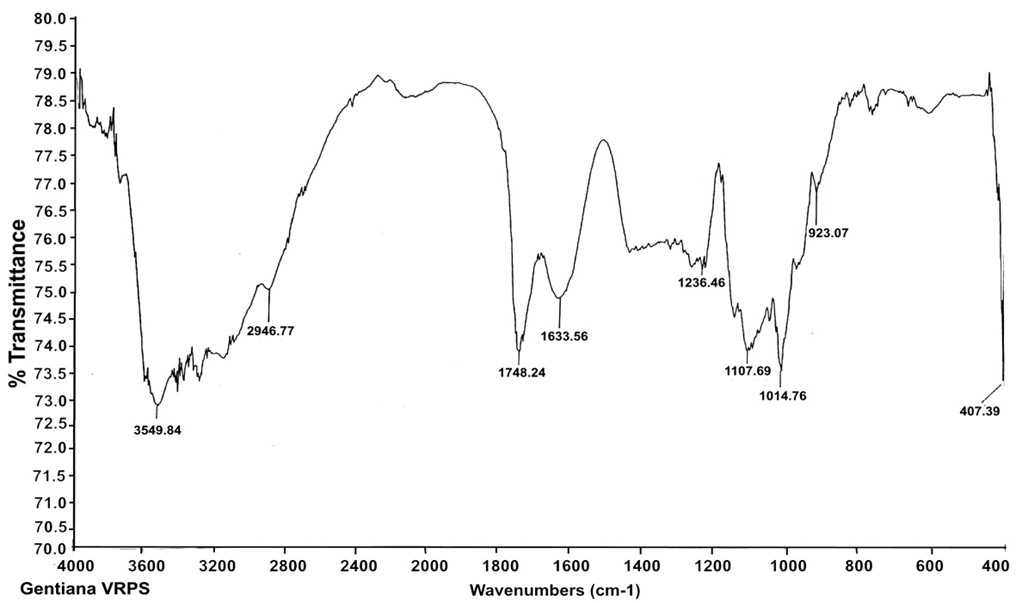ISOLATION AND STUDY OF THE PHYSICOCHEMICAL PROPERTIES OF POLYSACCHARIDES FROM PLANT MATERIALS GENTIANA OLIVIERI GRISEB
UDC 54.056: 577.114.083
Abstract
Methods for isolating and purifying polysaccharides of the aerial part from plant materials of the Gentian Olivier – Gentiana. Olivieri Griseb (family Gentianaceae ) have been developed and studied for the qualitative and quantitative content of polysaccharides in the herb as biologically active components that determine its anti-inflammatory and sequestering (moisture retention agents) effects in the normalization of gastrointestinal disorders. The qualitative and quantitative characteristics of the content of the polysaccharide complex were determined, including water-soluble polysaccharides obtained from a neutral medium with a yield of 6.4%, water-soluble polysaccharides obtained from an acidic medium with a yield of 0.9%, and pectin substances with a yield of 3.8%. The monomeric composition of water-soluble polysaccharides from both neutral and acidic treatments is represented by D-galactose, L-arabinose, and D-glucose. Pectin substances consisting of D-galactose, L-arabinose and D-glucose, D-galacturonic acid dominate the polysaccharide composition of the medicinal plant. They turned out to be highly esterified. The absorption bands of the infrared spectrum of the polysaccharide indicate the presence of α-glycosidic bonds between the residues of D-galacturonic acid in the polysaccharide.
Downloads
Metrics
References
Li F.S., Weng J.K. Nature plants, 2017, vol. 3, no. 8, pp. 1–7. DOI: 10.1038/nplants.2017.109.
Rastitel'nyye lekarstvennyye sredstva Abu Ali ibn Sino (Avitseny). Spravochnik. [Herbal medicines Abu Ali ibn Sino (Avicene). Directory], ed. Sh.B. Irgashev. Tashkent, 2003, 457 p. (in Russ.).
Mirzaee F., Hosseini A., Jouybari H.B., Davoodi A., Azadbakht M. Journal of traditional and complementary medi-cine, 2017, vol. 7, no. 4, pp. 400–408. DOI: 10.1016/j.jtcme.2016.12.013.
Avicenna A. Ghanoon dar teb. Soroosh, 1988, pp. 244–251.
Sattarov D.S. Bioraznoobraziye i resursy dikorastushchikh lekarstvennykh rasteniy v nekotorykh rayonakh Tsentral'nogo Tadzhikistana: avtoref. dis. … dokt. biol. nauk. [Biodiversity and resources of wild medicinal plants in some areas of Central Tajikistan: abstract dis. … doc. biol. Sciences]. Novosibirsk, 2019, 36 p. (in Russ.).
Sakhobiddinov S.S. Dikorastushchiye lekarstvennyye rasteniya Sredney Azii. [Wild medicinal plants of Central Asia]. Tashkent, 1948, 216 p. (in Russ.).
Khodzhimatov M. Dikorastushchiye lekarstvennyye rasteniya Tadzhikistana. [Wild medicinal plants of Tajikistan]. Du-shanbe, 1989, 368 p. (in Russ.).
Khalilova F.A. Biologiya i integrativnaya meditsina, 2016, no. 2, pp. 147–153. (in Russ.).
Khozhimatov O.K. Lekarstvennyye rasteniya Zapadnogo Tyan'-Shanya (v predelakh Respubliki Uzbekistan): avtoref. dis. … dokt. biol. nauk. [Medicinal plants of the Western Tien Shan (within the Republic of Uzbekistan): abstract dis. … doc. biol. Sciences]. Tashkent, 2008, 40 p. (in Russ.).
Takeda Y., Masuda T., Honda G., Takaishi Y., Ito M., Ashurmetov A., Khodzhimatov K. Chem. Pharm. Bull., 1999, vol. 47(9), pp. 1338–1340. DOI: 10.1248/cpb.47.1338.
Gammerman A.F., Grom I.I. Dikorastushchiye lekarstvennyye rasteniya SSSR. [Wild medicinal plants of the USSR]. Moscow, 1976, 288 p. (in Russ.).
Rakhimova G.K., Komilov Kh.M. Universum: khimiya i biologiya, 2019. no. 2(56). URL: http://7universum.com/ru/nature/archive/item/6813. (in Russ.).
Blinova M.P., Dudarev V.G., Kotova N.I. Rastitel'nyye resursy, 2007, vol. 43, no. 4, pp. 95–101. (in Russ.).
Azizov D.Z., Saburova A., Azizova D.SH., Rakhmanberdyyeva R.K. Science Time, 2019, no. 2(62), pp. 38–43. (in Russ.).
Kodiralieva F.A., Rakhmanberdyeva R.K. Chemistry of natural compounds, 2011, vol. 47, no. 1, pp. 7–9. DOI: 10.1007/s10600-011-9818-3.
Kodiraliyeva F.A., Rakhmanberdyyeva R.K., Mezhlumyan L.G., Malikova M.Kh. Rastitel'nyye resursy, 2013, vol. 49, no. 4, pp. 558–564. (in Russ.).
Harris D.C. Quantitative chemical analysis. NY, 2010, 892 p.
Li X., Zhao R., Zhou H.L., Wu D.H. Advanced Materials Research, 2012, vol. 340, pp. 416–420. DOI: 10.4028/www.scientific.net/AMR.340.416.
Minevich I.E. et al. Izvestiya VUZov. Prikladnaya khimiya i biotekhnologiya, 2021, vol. 11, no. 3(38), pp. 449–459, DOI: 10.21285/2227-2925-2021-11-3-449-459. (in Russ.).
Hong T., Yin J.Y., Nie S.P., Xie M.Y. Food chemistry: X, 2021, vol. 12, article 100168. DOI: 10.1016/j.fochx.2021.100168.
Bichara L.C., Alvarez P.E., Bimbi M.V.F., Vaca H., Gervasi C., Brandán S.A. Infrared Physics & Technology, 2016, vol. 76, pp. 315–327. DOI: 10.1016/j.infrared.2016.03.009.
Černá M., Barros A.S., Nunes A., Rocha S.M., Delgadillo I., Čopı́ková J., Coimbra M.A. Carbohydrate Polymers, 2003, vol. 51, no. 4, pp. 383–389. DOI: 10.1016/S0144-8617(02)00259-X.
Kacurakova M., Capek P., Sasinkova V., Wellner N., Ebringerova A. Carbohydrate polymers, 2000, vol. 43, no. 2, pp. 195–203. DOI: 10.1016/S0144-8617(00)00151-X.
Xie Y. et al. Polymers, 2020, vol. 12, no. 3, p. 608. DOI: 10.3390/polym12030608.
Patent 2469558 (RU). 20.12.2012. (in Russ.).
Novikova V.P., Khavkin A.I., Shapovalova N.S. Voprosy prakticheskoy pediatrii, 2018, vol. 13, no. 5, pp. 62–67. DOI: 10.20953/1817-7646-2018-5-62-67. (in Russ.).

Copyright (c) 2023 chemistry of plant raw material

This work is licensed under a Creative Commons Attribution 4.0 International License.

This work is licensed under a Creative Commons Attribution 4.0 International License.
The authors, which are published in this journal, agree to the following conditions:
1. Authors retain the copyright to the work and transfer to the journal the right of the first publication along with the work, at the same time licensing it under the terms of the Creative Commons Attribution License, which allows others to distribute this work with the obligatory indication of the authorship of this work and a link to the original publication in this journal .
2. The authors retain the right to enter into separate, additional contractual agreements for the non-exclusive distribution of the version of the work published by this journal (for example, to place it in the university depository or to publish it in a book), with reference to the original publication in this journal.
3. Authors are allowed to post their work on the Internet (for example, in a university repository or on their personal website) before and during the review process of this journal, as this may lead to a productive discussion, as well as more links to this published work.











